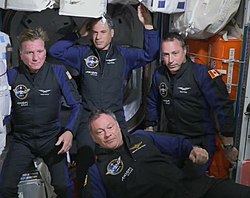- Ax-1 and Artemis 1 on adjacent pads before launch
- Launch of Ax-1
- Falcon 9 and Ax-1 pitching downrange
- Ax-1 approaching the ISS
 Ax-1 approaching the ISS | |
| Names | Ax-1 |
|---|---|
| Mission type | Private spaceflight to the ISS |
| Operator | |
| COSPAR ID | 2022-037A |
| SATCAT no. | 52204 |
| Website | axiomspace |
| Mission duration | 17 days, 1 hour, 49 minutes |
| Spacecraft properties | |
| Spacecraft | Crew Dragon Endeavour |
| Spacecraft type | Crew Dragon |
| Manufacturer | SpaceX |
| Launch mass | 12,519 kg (27,600 lb) |
| Landing mass | 9,616 kg (21,200 lb) |
| Crew | |
| Crew size | 4 |
| Members | |
| Start of mission | |
| Launch date | April 8, 2022, 15:17:12 UTC (11:17:12 am EDT) [1] |
| Rocket | Falcon 9 Block 5 B1062-5 |
| Launch site | Kennedy, LC‑39A |
| Contractor | SpaceX |
| End of mission | |
| Recovered by | MV Megan |
| Landing date | April 25, 2022, 17:06 UTC [2] |
| Landing site | Atlantic Ocean |
| Orbital parameters | |
| Reference system | Geocentric orbit |
| Regime | Low Earth orbit |
| Inclination | 51.66° |
| Docking with ISS | |
| Docking port | Harmony zenith |
| Docking date | April 9, 2022, 12:29 UTC |
| Undocking date | April 25, 2022, 01:10 UTC |
| Time docked | 15 days, 12 hours, 41 minutes |
 Axiom Mission 1 patch  Clockwise from left: Connor, Stibbe, Pathy and López-Alegría | |
Axiom Mission 1 (or Ax-1) [3] was a privately funded and operated crewed mission to the International Space Station (ISS). The mission was operated by Axiom Space out of Axiom's Mission Control Center MCC-A [4] in Houston, Texas. The flight launched on April 8, 2022, from Kennedy Space Center in Florida. [5] The spacecraft used was a SpaceX Crew Dragon. The crew consisted of Michael López-Alegría, [6] a Spaniard-American and a professionally trained astronaut hired by Axiom, Eytan Stibbe [7] from Israel, [8] Larry Connor from the United States, [8] and Mark Pathy from Canada. [8]







